Artificial intelligence (AI) and predictive analytics (PA) are rapidly transforming how landscaping businesses run their operations, from delivering better service to making smarter decisions and gaining a competitive edge.
In a recent Aspire webinar, Robert Clinkenbeard, CEO of Wilson360 and former landscaping business owner, and Cris Poggi, Director of Sales Engineering at Aspire, discuss the transformative power of AI and PA and preview how these technologies will drive the future of operational excellence in the landscaping industry.
“Aspire is a part of this transformation,” Poggi says. “The business is definitely engaged in making sure we're aligned with technology trends. It's imperative that as a software company, we remain innovative and nimble and really incorporate current software market trends.”
The transformational impact of AI

Clinkenbeard shared several key statistics to demonstrate how AI and PA are rapidly transforming all industries today and explained how the impact will only grow more profound in the near future.
The global market for AI is expected to grow from $58 billion in 2021 to $309 billion by 2026
Companies leveraging AI will increase their cash flow by more than 120% by 2030
74% of global enterprises have either implemented or are planning to implement AI in their business operations
AI can potentially deliver up to $4.4 trillion in global economic value annually
58% of businesses currently use AI to drive greater efficiency and cut costs
Companies with AI-led processes achieve 2.5x higher revenue growth and 2.4x greater productivity compared to their peers
Aspire’s 2025 Landscape Industry Report shows landscapers believe technology will benefit the industry, with 73% of respondents seeing digital transformation as “somewhat or very important.”
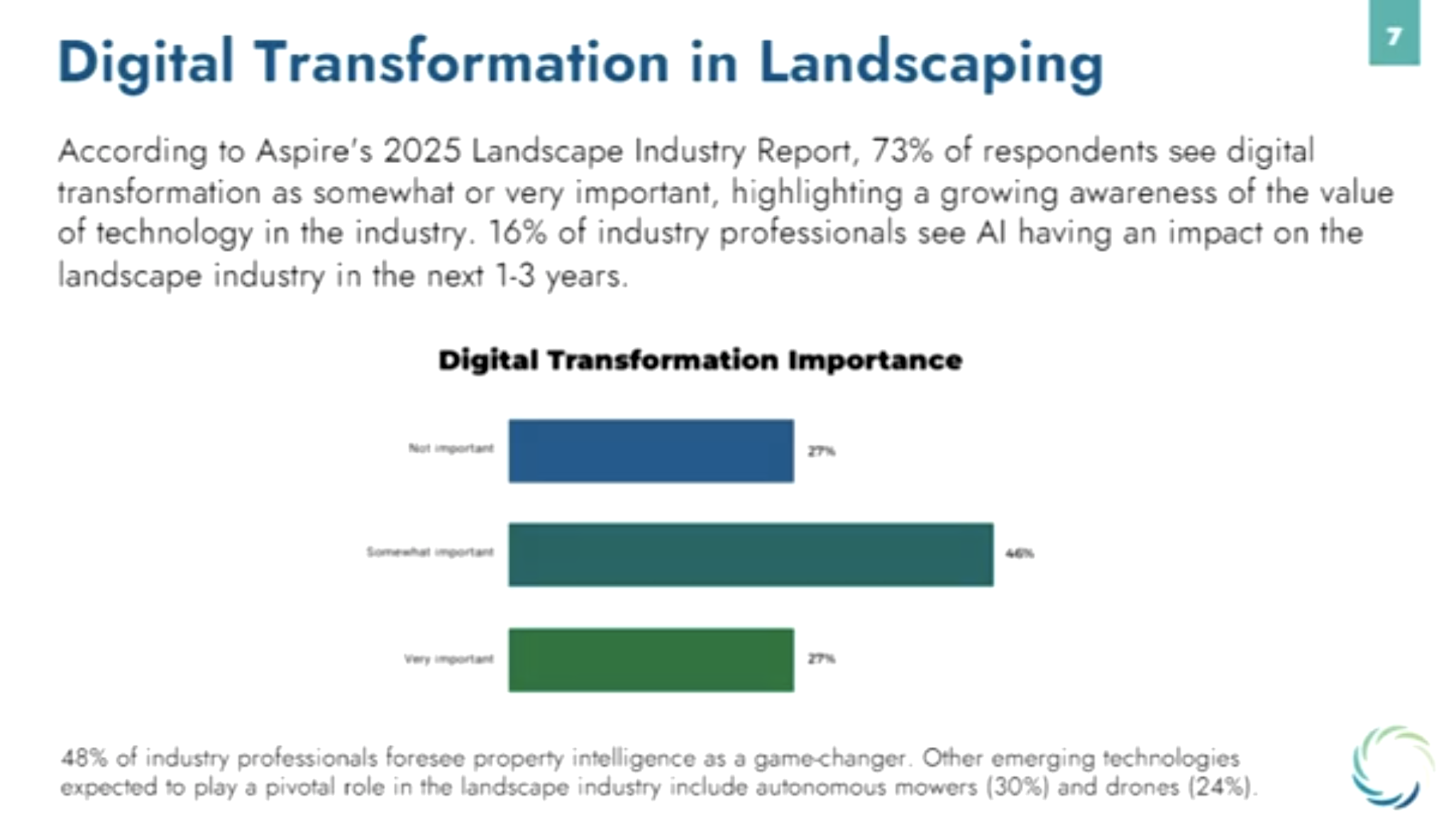
Clinkenbeard explained how most major companies now use AI and PA to personalize product recommendations, optimize supply chains, and drive revenue growth.
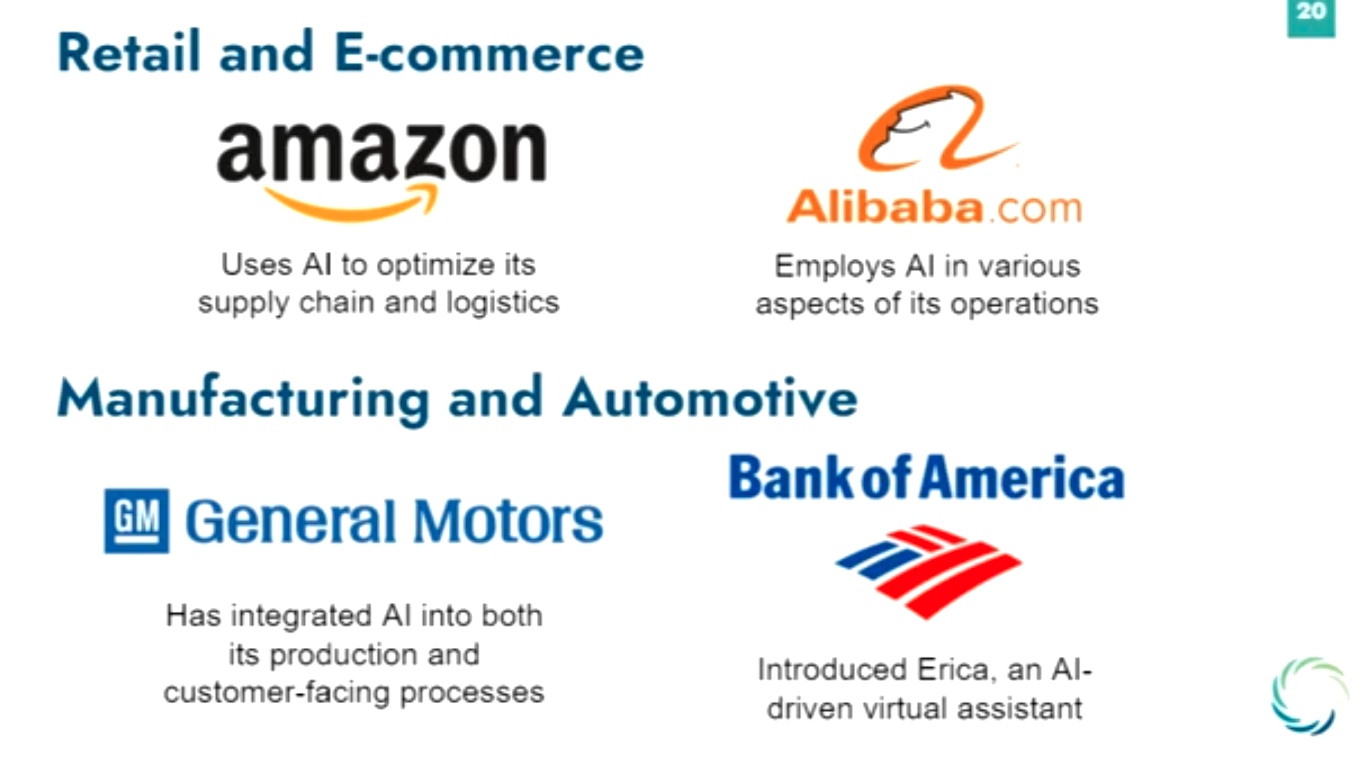
“You look at giants like Google. They apply AI to improve core services and business processes, optimizing ad placements, search algorithms, and data centers.
“You probably wonder why things pop up that you enjoy watching on Netflix,” he adds. “They use AI and algorithms to personalize content recommendations, to manage streamlining quality, and to optimize content production strategy. These big companies obviously have deep pockets and a huge amount of staff, but this trend is continuing to rapidly come down the tunnel.”
Despite the benefits, Aspire’s Industry Report found only 17% of landscaping companies currently use AI. However, the 17% who have implemented AI report a positive impact on their businesses.
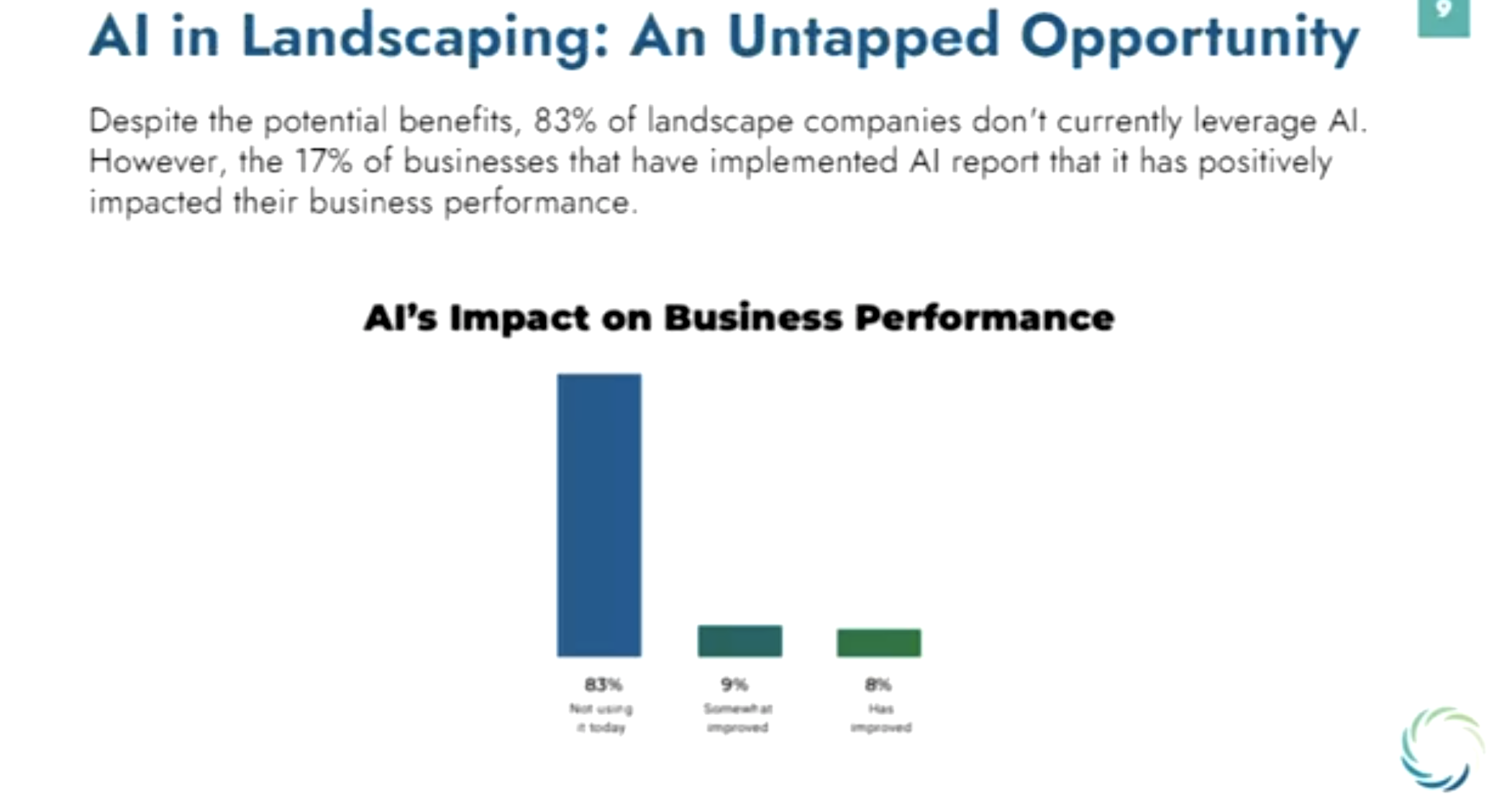
Greatest areas of potential for AI in landscaping
Aspire’s 2025 report shows landscapers believe AI will have the biggest impact on:
Field operations: 39%
Routing: 33%
Scheduling: 30%

Poggi explained how landscapers can use AI to perform predictive maintenance for equipment and optimize job planning for sites they may serve only once per week. AI-led smart routing makes real-time adjustments based on traffic patterns to help landscaping pros minimize travel time and use less fuel.
For design and planning, AI can help landscapers create realistic plans and optimize planting schematics based on inputs like terrain, climate data, and sun exposure. Poggi says contractors are increasingly using AI-equipped drones for site inspections and robotic lawnmowers powered by automation.
Automated chatbots can help users navigate landscaping websites and answer common questions, improving the customer experience and conserving resources.
“We can all relate to the biggest issue we hear in our peer group meetings about there not being enough labor,” Clinkenbeard says. “But if you're able to use AI to help manage resources, labor, equipment, materials, cost estimation, and supply chain optimization—if you can streamline all of that—you can make some tremendous savings on your gross margin.”
Understanding the power of predictive analytics
Predictive analytics is a branch of advanced analytics that uses current and historical data to forecast future events, behaviors, and outcomes. It employs statistical techniques, machine learning algorithms, and sophisticated predictive modeling to analyze patterns in data and assess the likelihood of future occurrences.
“Consider a large HOA that needs to maintain numerous communal green spaces, gardens, and recreational areas,” Clinkenbeard says. “You can use PA to analyze past maintenance records, local weather trends, and plant growth cycles to forecast when different areas will require specific services like pruning, watering, and fertilizing.”
Clinkenbeard says data-driven insights can help businesses better manage labor, allocate resources ahead of time, and proactively address issues before they become a costly problem.
How landscaping companies can use predictive analytics
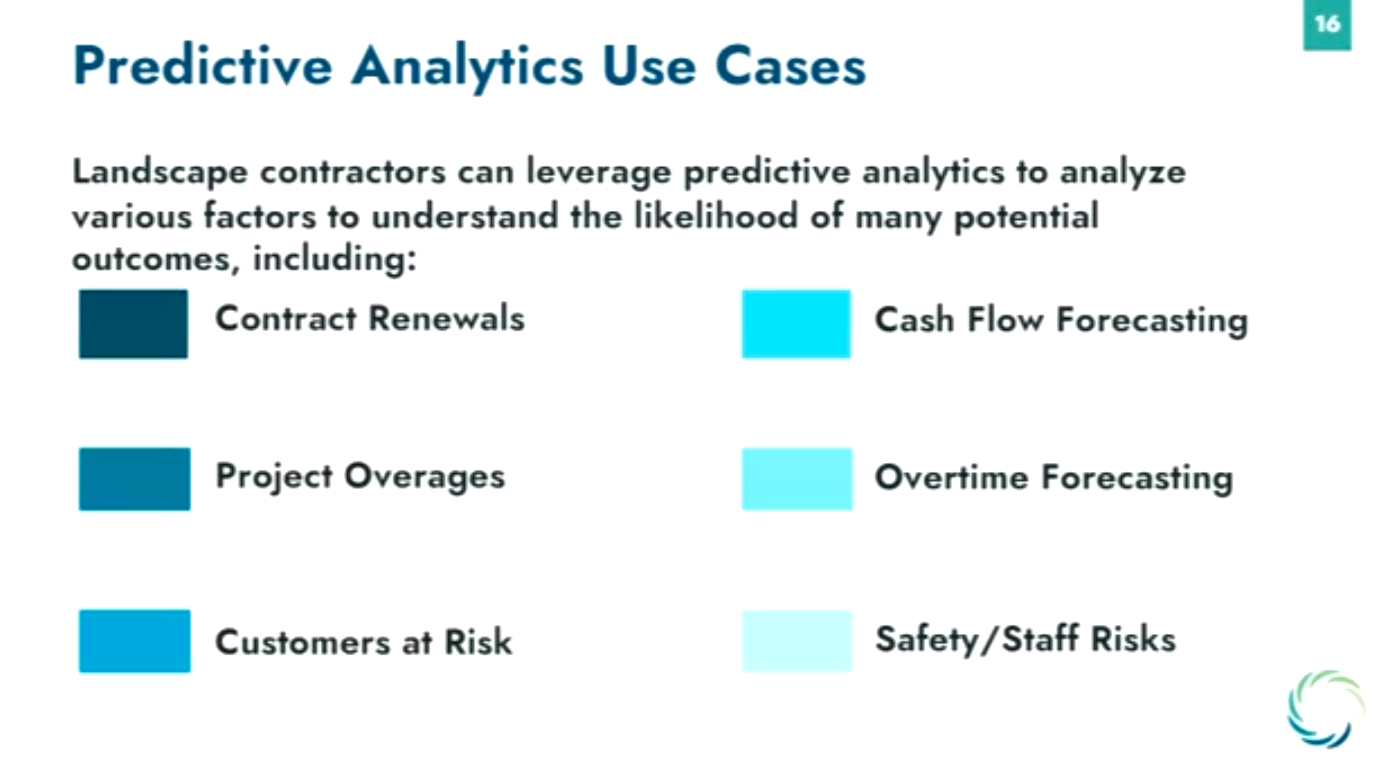
Predicting outcomes is nothing new for landscapers, Poggi says, but now it has a “fancy name” and is becoming more prevalent in the industry.
“For the action items we’ve been using to predict outcomes, we've typically self-managed within the business,” Poggi says. “If we had a technical team, we were maybe one step ahead. Tools like Aspire will help create predictive analytics and put us on a road of efficiency.”
Clinkenbeard says landscapers can leverage PA for:
Contract renewals
Project overages
Customers at risk
Cash flow forecasting
Overtime forecasting
Safety and staffing risks
“Every day, we're getting more and more data thrown at us, and now it's just a case of ‘How do we best use it to make the best decisions possible?’” Clinkenbeard says.
When done effectively, PA can provide the following benefits:
Improved decision-making
Risk mitigation
Operational efficiency
Customer insights
Competitive advantage
Clinkenbeard says his organization previously spent countless hours analyzing customer feedback. After using AI tools, he says the company can now spot trends in real-time.
“Just having those insights allows us to adapt and be nimble on the ground and figure out what we need to do on the operational side to meet our customers’ needs,” Clinkenbeard says.
2024 case study
To demonstrate the power of AI in the landscaping industry, Clinkenbeard shared a case study on one of his consulting clients who was struggling to grow the organization.
The company wanted to improve client communication, account management, and interaction. Based on the East Coast, they were facing challenges with renewal rates. Their retention rate was in the low 80s, and the enhancement penetration rate (increasing market share by improving existing products) was lower than the industry average.
“They started to use some AI-driven insights for labor, equipment, and material management,” Clinkenbeard says. “They started to look at communication in particular, just to put some benchmarks down on different-size customers and how quickly or how often or frequently they should be communicated with.
“AI was used to overlay email, text messages, and phone calls to track how frequently they should be communicating with them,” he adds. “Some of the results were really amazing.”
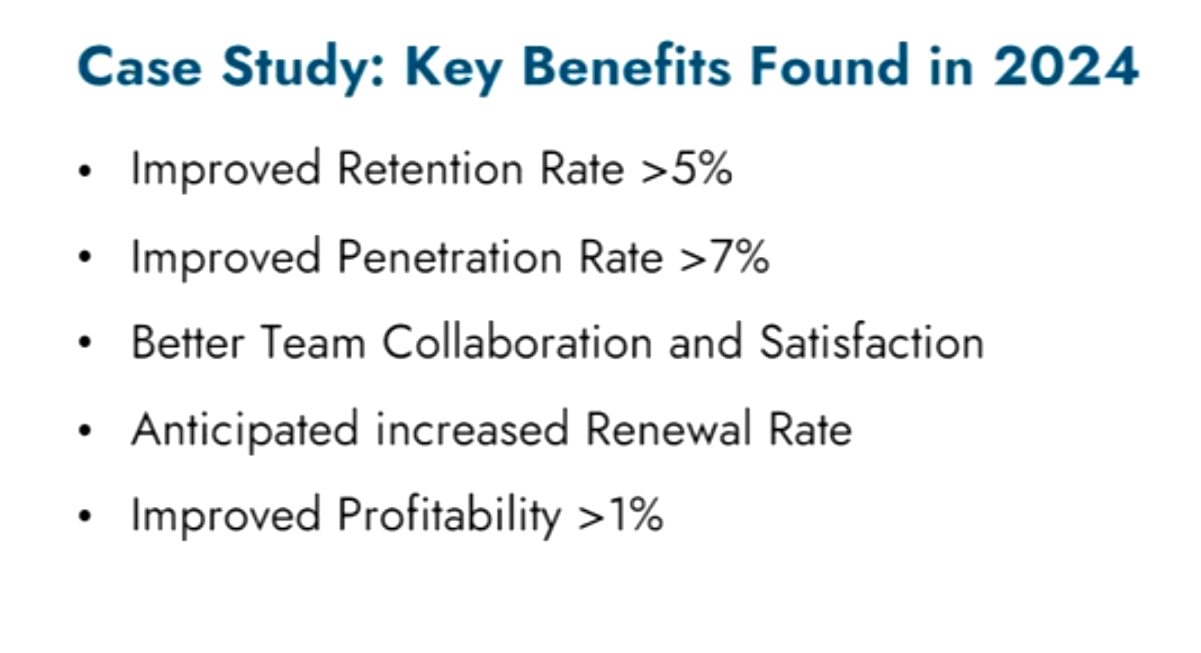
Aspire and AI: Current state and future state

Poggi provided some examples of how current Aspire users can leverage AI and PA to optimize their business operations and also previewed new AI features Aspire plans to roll out over 2025.
Current state of AI in Aspire
User guide: Leverages AI to query various Aspire resources and easily find answers to any question about the platform. “It’s always great to be able to answer your team's questions without escalating to our care team,” Poggi says.
PropertyIntel integration: Measure, map, and visualize faster than ever with AI-assisted measurements. “We leverage your map’s AI data to auto-detect things like turf, asphalt, and water to allow for automated measuring,” Poggi says. “If you're dealing with quoting and possibly looking at regional sites outside of your specific region, this can really help you to understand the risk and what the need is for that particular property, so you can estimate appropriately.”
Measuring client health: Poggi explains how Aspire users can mine existing data, including account interactions, payment patterns, open issues, days to closed issues, and site audit scores to perform predictive analysis.
Future state of AI in Aspire
Customer communications: Easily craft clear and concise messages to communicate better and faster with customers. “This will help our users with more professional emails and be especially helpful for staff that might speak English as a second language,” Poggi says. “For example, the user could indicate the requested tone of the email, if they want it professional, or if they want it friendly. That tone will pass through the AI enhancer and then is passed back into Aspire.”
Vendor invoice entry: Instantly create invoice entries by snapping and uploading an image of the vendor’s invoice. “We're working on using optic character interaction for vendor invoices, scanning those invoices, having the invoice come up through the application, and knowing which Aspire data fields the invoice contact should be mapped to,” Poggi says.
Language translation: Automatically translate text within Aspire to any language based on the specific user’s settings, whether on desktop or mobile. “This is going to allow for clearer communication and fewer misunderstandings, no matter what language barriers might exist,” Poggi says.
Churn prediction: Uses PA to understand which accounts are at risk—and why—so you can take proactive action to preserve the relationship. “Aspire will do the calculations for our end users and present them in the application, so it's easy to see what's at risk and what's not, to help our clients know where to spend time,” Poggi says.
To learn more about how to harness the power of predictive analytics and AI to transform your operations, view the full webinar on demand.










